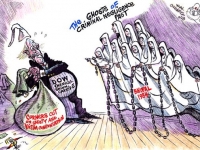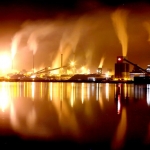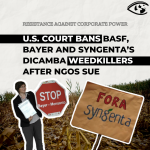Dynamite in the Center of Town
Bhopal at Twenty

When I first visited Bhopal, a small Indian city of about one million, it was early 1990. The Union Carbide pesticide factory, by then a dilapidated, rusting hulk of a ruin, sat like a silent specter at the edge of town, bordering on vibrant slums filled with swarms of bicycles and motorized rickshaws. Graffiti covered the factory walls. The most evocative drawing was a skull and crossbones with the words "Killer Carbide," scrawled across it. A memorial statue sat just outside, depicting a mother clutching a baby to her breast.
This week marks twenty years since a huge invisible cloud of methyl isocyanate (MIC) gas escaped from the factory and killed more than 8,000 people overnight. It injured tens if not hundreds of thousands more. Together with the Chernobyl nuclear disaster, Bhopal is one of the two worst industrial disasters in history.
One would think that two decades after such a horrendous event, some sort of closure would be at hand. But nothing could be further from the truth. Today survivors groups continue to clamor in an unrequited struggle for justice. Michigan-based Dow Chemical, which gobbled up the assets of the mortally wounded Union Carbide Corporation in 2000, is besieged with a series of protests and law suits charging it with criminal liability, urging compensation and health care for the victims, and calling for a clean-up of the abandoned toxic factory site.
More than 20,000 deaths are attributed to the disaster today. Survivors and their children continue to suffer long-term health effects ranging from cancer and tuberculosis to birth defects and chronic fevers. The impacts of the MIC gas now appear to be multigenerational.
"We are still finding children being born without lips, noses or ears," says Bhopal survivor Rashida Bee, who won the Goldman Environmental Prize this year for her two decades of activism. "Sometimes complete hands are missing, and women have severe reproductive problems." Bee herself still suffers from respiratory and vision problems from the gas disaster.
Growing Relevance
The longevity of the Bhopal issue is somewhat surprising to many, no matter which side of the story you're on. Certainly Dow, having knowingly inherited the disaster when it acquired Union Carbide, did not anticipate the extent to which Bhopal would persist as a symbol of corporate negligence and cold heartedness in the public eye.
Indeed, the struggle to hold the company and its executives, including former Union Carbide CEO Warren Anderson, accountable for their sins in Bhopal has only grown over the years. "Astonishingly," says Amnesty International in a new report published this week, "no one has been held to account for the toxic leak and its appalling consequences."
On the 20th Anniversary Dow insists that "the claims arising out of the release were settled 15 years ago." The company also continues to claim that "the gas leak could only have been caused by deliberate sabotage." But even this long-standing assertion has gained a new, ironic significance post 9-11, boomeranging on the company and the chemical industry in general.
It still seems highly improbable that a saboteur committed such a heinous crime in India in 1984. But the possibility of a terrorist strike against a US chemical facility, resulting in a Bhopal-like massacre of tens if not hundreds of thousands of people, looms large in 2004.
According to the Environmental Protection Agency, there are more than 120 chemical facilities in the United States that, if attacked by terrorists, could each threaten more than a million people. Yet the chemical industry, Dow included, has successfully lobbied Congress and the Bush administration to go easy on them, not impose strict chemical security measures and not mandate the use of safer chemicals.
Meanwhile, back at the factory site, the disaster continues in slow motion. A legacy of toxic contamination is imposing another round of poisoning on the community. Multiple studies have found nickel, mercury and other toxins in the local groundwater, along with dangerous levels of toxins in the breast milk of women who live near the factory zone.
In short, 20 years after the disaster, Bhopal remains unfortunately relevant-an icon of our times. It is a cautionary tale of globalization run amok and the horror of industrial disaster. It is a powerful poster child for the need for greater corporate accountability and chemical security to protect both public health and the environment.
Books, documentary films and street protests continue to pour forth on the subject, speaking to its ongoing or even increased resonance.
"Bhopal," says Gary Cohen, Director of the Boston-based Environmental Health Fund, "is now."
The Price of An American Dog
During my first visit to Bhopal I learned how the factory came to be there. Union Carbide was producing pesticides for cotton crops -- taking advantage of a World Bank-financed "green revolution" plan to promote large-scale chemical-based agribusiness in the Indian countryside. As it turned out, the entire set-up benefited large multinational corporations like Carbide far more than it did local Indian farmers. Many Indians were displaced from their lands by the green revolution. In all probability some of the people living in the shanty town next to the factory on that fateful night of December 3, 1984 were landless migrants -- collateral damage from green revolution -- desperate souls who had come to the city of Bhopal, seeking work.
Just over five years had elapsed since the disaster that claimed so many lives. At that moment it seemed like a long time. Yet the level of organizing and mobilization taking place in the community impressed me. A group of women survivors were preparing to initiate a hunger strike in New Dehli, demanding just compensation. "We are the women of Bhopal," they chanted, "we are not flowers, we are flames."
I returned to Bhopal five years later, in 1994--nearly a decade after the gas disaster-which had begun to seem like a venerable moment in history by that point. The slums near the factory were still mobilized and militant. The survivors continued to call for just compensation, for Warren Anderson's extradition, and for adequate health care for their unique needs.
They were also protesting against the latest version of an obscure international accord -- the General Agreement on Tariffs and Trade (GATT); it was an agreement poised to spawn a new global institution now known as the World Trade Organization. "GATT will bring us more Bhopals," local activist Abdul Jabbar Khan told me. "The Indian government has not listened." At a demonstration, I witnessed survivors' groups burning side by side effigies of Carbide's Anderson -- an extremely tangible symbol of corporate negligence -- and Arthur Dunkel, a virtually unknown bureaucrat, but head of the GATT and symbolic precusor to the WTO.
I also visited the winding, ramshackle back alleys of Nagar Nigam colony, near the old factory. Children played with abandon. Neighbors sat in front of their houses and shot the breeze. It is here that Ishrat Siddiqui, a man who lived through the disaster, diverted a conversation about the night the poison cloud descended to ask me about the price of an American dog. "An American dog?" I replied quizzically. "I bet you," said Siddiqui, "that an American dog costs more than an Indian life."
As it turned out, Siddiqui's street economics were nearly on the mark. Carbide had managed to maneuver legal proceedings out of the United States and into India. It then settled out of court with the Indian government-which was determined to attract more foreign investment, not repel it-for a paltry $470 million. As the settlement money started making its way to survivors and relatives, each death was valued at $3,000: the price at the time of not one, but two high-pedigreed American dogs.
To this day the Indian government has still not disbursed all the settlement money, which has sat in an account, accruing interest. But you can still get a French bulldog puppy in California for $1,650.
As I winged my way back to San Francisco, I thought about the legal settlement in another high-profile corporate-driven disaster: the 1989 Exxon Valdez oil spill for which plaintiffs were awarded $5 billion. A heinous crime against the environment to be sure - but no human beings ever died. Clearly, for global corporations, human life was a lot cheaper in the so-called Third World.
Upon my return home, and around the time of the 10th anniversary, I met up with a man named Edward Munoz. An Argentine by birth, Munoz had run Union Carbide's operations in India in the 1960s and 1970s, and had presided over the construction of the Bhopal facility.
Munoz described the process of planning and building the factory as "a childish comedy of errors." He made it clear to me that he thought the Union Carbide corporation had been negligent to store a volatile chemical like MIC in large tanks, rather than 55 gallon drums as he had advocated for.
Munoz likened the "bigger the better" design to bringing "dynamite to the center of town." Of course, he added, "dynamite doesn't explode normally.... But unusual events happen all the time." (read the full interview here)
Besides legal maneuverings to avoid liability for the carnage in Bhopal, Carbide's most significant response to the disaster was to work with the rest of the chemical industry to create a program called Responsible Care. Like most voluntary industry initiatives, it was designed to stave off government regulation and as a public relations effort to rehabilitate tarnished corporate images. In the words of public relations guru E. Bruce Harrison, who helped create the program, it "was born out of a negative public image of the chemical industry," and intended "to reassure worried publics - especially neighbors of chemical plants - that nearby facilities are being operated safely, and that the company that owns the facilities cares about their employees and the community."
Ironically, the industry initiated and implemented Responsible Care almost exclusively in the United States and Europe. Thus even this weak, voluntary initiative didn't apply to the rest of the world, leaving global corporations like Dow in places like India off the hook.
Global Justice and Bhopal
While corporations stepped up their public relations spin and double standards, in many respects the tireless struggle of the survivors of Bhopal and the emergence of an international campaign to support them foreshadowed what we know today as the anti-corporate globalization and global justice movement.
For instance, eight years ago, just after the 12th anniversary of Bhopal, we launched the CorpWatch website with an image gallery dedicated to the survivors (December 10, 1996). Our overall effort was very much informed by the Bhopal legacy and our experience on the ground there. We were inspired by the survivors' perseverance, and motivated by the possibilities of global organizing for corporate accountability that Bhopal demonstrated. We took the Bhopal experience and applied it to the problems and challenges raised by corporate globalization.
And then, a full fifteen years almost to the day after the Bhopal gas disaster, 50,000 largely non-violent protestors took to the streets of Seattle to resist the policies of the World Trade Organization. The central issues demonstrators raised in Seattle, the growing primacy of corporate power over local interests, and the expendability of third world peoples in the global economy, were magnified echoes of the Bhopal survivors' cry for justice on a global scale.
The struggle in Bhopal fed into the battle in Seattle. And the battle in Seattle reinforced the struggle in Bhopal.
A Beacon of Hope
Despite the ongoing problems, there is also an ongoing beacon of hope emanating from Bhopal. The community is still organized.
With substantial help from abroad they've created a health clinic that caters to and documents their unique needs. On an international level, the survivors have made common cause with others challenging the global chemical giant, including Agent Orange victims, dioxin-poisoned factory communities in Michigan, and those sickened by asbestos.
Meanwhile, international legal initiatives still aim to pin criminal liability on former Carbide executives such as Warren Anderson. Recently, after years of organizing by the survivors, the Indian government issued an extradition order for Anderson (the U.S. has rejected it and Anderson remains at large - reportedly in a gated community in Florida).
The survivors are also working with their international allies to force Dow to clean up the contaminated factory site and compensate people whose drinking water has been poisoned. And they are campaigning to compel Dow to finance long-term, multigenerational health care for the victims and their families. Activists around the world are organizing an international day of protest for the 20th anniversary.
Achieving any one of these three - criminal liability, clean-up, or long-term health care - would be a significant victory. But such triumphs are hard won and slow in coming. What seems clear is that the survivors aren't giving up. If they do not win these victories today, the 30th anniversary of Bhopal will most likely dawn with demonstrations around the world, led by the survivors and their children. Bhopal will not be forgotten.
In this respect, the survivors' long struggle for justice, and the international effort that has coalesced around them, is already reaping a significant victory for people all over the world. Through their perseverance, the people of Bhopal have put global corporations on notice that they cannot escape the consequences of their actions, even decades later. Or in the words of a somewhat infamous American politician: they can run, but they can't hide.
Joshua Karliner is CorpWatch's founder and was executive director from 1996-2002. Today he is a member of the CorpWatch executive board, and is pursuing various writing and consulting projects.



